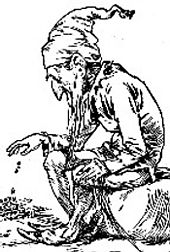The earliest known reference to the leprechaun appears in the medieval tale known as the Echtra Fergus mac Léti (Adventure of Fergus son of Léti).[8] The text contains an episode in which Fergus mac Léti, King of Ulster, falls asleep on the beach and wakes to find himself being dragged into the sea by three lúchorpáin. He captures his abductors, who grant him three wishes in exchange for release.
The leprechaun is said to be a solitary creature, whose principal occupation is making and mending shoes, and who enjoys practical jokes. According to William Butler Yeats, the great wealth of these fairies comes from the "treasure-crocks, buried of old in war-time", which they have uncovered and appropriated.] According to David Russell McAnally the leprechaun is the son of an "evil spirit" and a "degenerate fairy" and is "not wholly good nor wholly evil".
Appearance
The leprechaun originally had a different appearance depending on where in Ireland he was found. Prior to the 20th century, it was generally held that the leprechaun wore red, not green. Samuel Lover, writing in 1831, describes the leprechaun as,
According to Yeats, the solitary fairies, like the leprechaun, wear red jackets, whereas the "trooping fairies" wear green. The leprechaun's jacket has seven rows of buttons with seven buttons to each row. On the western coast, he writes, the red jacket is covered by a frieze one, and in Ulster the creature wears a cocked hat, and when he is up to anything unusually mischievous, he leaps on to a wall and spins, balancing himself on the point of the hat with his heels in the air."
According to McAnally,
This dress could vary by region, however. In McAnally's account there were differences between leprechauns or Logherymans from different regions:
- The Northern Leprechaun or Logheryman wore a "military red coat and white breeches, with a broad-brimmed, high, pointed hat, on which he would sometimes stand upside down".
- The Lurigadawne of Tipperary wore an "antique slashed jacket of red, with peaks all round and a jockey cap, also sporting a sword, which he uses as a magic wand".
- The Luricawne of Kerry was a "fat, pursy little fellow whose jolly round face rivals in redness the cut-a-way jacket he wears, that always has seven rows of seven buttons in each row".
- The Cluricawne of Monaghan wore "a swallow-tailed evening coat of red with green vest, white breeches, black stockings," shiny shoes, and a "long cone hat without a brim," sometimes used as a weapon.
In a poem entitled The Lepracaun; or, Fairy Shoemaker, 18th century Irish poet William Allingham describes the appearance of the leprechaun as:
The modern image of the leprechaun sitting on a toadstool, red beard, green hat, etc., are clearly more modern inventions or borrowed from other European folklore.
Related creatures
The leprechaun is related to the clurichaun and the far darrig in that he is a solitary creature. Some writers even go as far as to substitute these second two less well-known spirits for the leprechaun in stories or tales to reach a wider audience. The clurichaun is considered by some to be merely a leprechaun on a drinking spree.





No comments:
Post a Comment